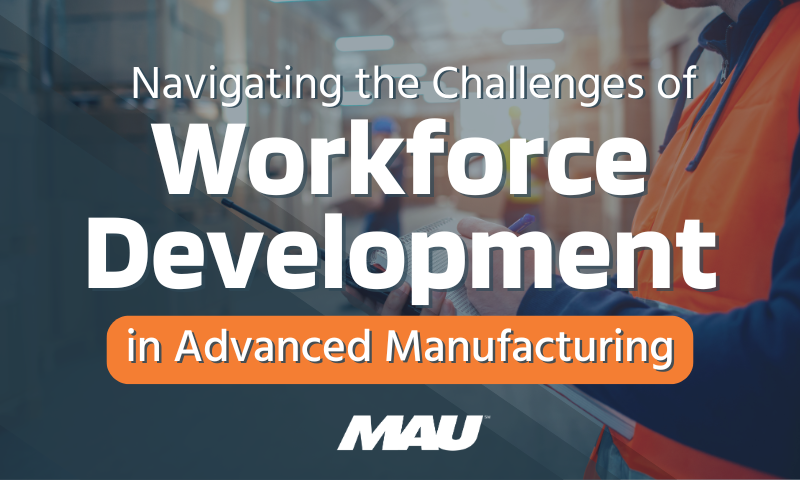The manufacturing industry is at a pivotal point in its evolution. With the advent of Industry 4.0, manufacturers are redefining how they derive and deliver value. Coupled with significant investments and growth expectations, the sector is poised for a dynamic transformation in 2024.
To help your business pull ahead of the pack, here is a forecast of the top 10 trends that will dominate the manufacturing industry in the coming year.
1. Technological Advancements and Modernization
Manufacturers recognize the importance of modernizing their legacy systems to meet the ever-increasing customer demands and evolving market trends. They are making substantial investments to ensure they stay competitive in the digital age. This modernization process involves not only upgrading infrastructure but also integrating cutting-edge technologies like artificial intelligence (AI) and the Internet of Things (IoT).
By leveraging these advanced technologies, manufacturers can unlock new levels of efficiency, productivity, and predictive capabilities. They embrace cloud-based solutions to enable seamless collaboration, real-time data access, and scalability, enhancing their overall agility and adaptability in a rapidly changing business landscape.
2. Robotics and Machine Learning
With the increasing demand for automation, robotics and machine learning are poised to revolutionize the manufacturing industry. By combining robotics with advanced AI and IoT capabilities, these technologies have the potential to perform repetitive tasks with greater speed and precision than humans, resulting in significant cost reductions and enhanced productivity.
Moreover, the integration of machine learning algorithms enables manufacturers to analyze vast amounts of data in real-time, empowering them to implement proactive measures such as predictive maintenance to minimize the risk of equipment failure. This convergence of robotics, AI, and machine learning is ushering in a new era of efficiency and innovation in manufacturing.
3. Workforce Transformation
The shifting dynamics of the job market have significantly increased the bargaining power of manufacturing employees. In response, employers are now actively prioritizing the creation of more favorable working conditions, aiming to attract and retain top talent in the industry.
This includes initiatives such as providing competitive compensation packages, fostering a positive work environment, offering growth opportunities, and implementing innovative employee benefits programs.
By investing in these measures, companies can not only enhance employee satisfaction but also position themselves as employers of choice in the competitive manufacturing landscape by creating more favorable working conditions to attract and retain talent.
4. Closing the Skills Gap
The manufacturing industry is facing a significant skills gap, with demand for skilled labor surpassing supply in several areas. To address this challenge, organizations are investing in upskilling and reskilling programs that enable their workforce to develop new competencies and stay relevant in a rapidly evolving market.
These initiatives will help bridge the skills gap and empower employees to take on new roles and responsibilities, fueling innovation and continuous improvement within organizations.
5. Supply Chain Transformation
Supply chain management is currently experiencing a significant transformation propelled by advancements in analytics and digitalization. This shift is revolutionizing the way businesses operate by providing unprecedented visibility into the intricacies of the supply chain.
With enhanced visibility, organizations can identify bottlenecks, optimize processes, and make data-driven decisions to improve efficiency and reduce costs at every stage of the supply chain. This comprehensive transformation is set to reshape the industry and unlock new opportunities for businesses to thrive in a hyperconnected world.
6. Rise of the Battery Manufacturing Industry
One of the most significant growth sectors in U.S. manufacturing is the battery industry, driven primarily by the surge in electric vehicle (EV) production and renewable energy solutions. Technological advancements and an increased focus on sustainability have led to a demand spike for high-capacity and efficient batteries.
This trend is propelling U.S. manufacturers to invest heavily in research, development, and production of next-generation battery technologies, bringing them to the forefront of the global battery market. The result is a vibrant and rapidly growing industry set to play a crucial role in shaping the future of energy storage and transportation, cementing the U.S.’s position as a global manufacturing leader.
7. Reshoring
In light of recent global disruptions, such as supply chain issues and economic uncertainties, many companies are carefully reevaluating their overseas operations and considering the benefits of bringing manufacturing back home.
This strategic shift not only aims to mitigate risks associated with global disruptions but also provides an opportunity for companies to have more control over their production processes and ensure quality standards. By localizing manufacturing, companies can foster a stronger connection with their domestic markets, contribute to job creation, and stimulate the growth of the domestic manufacturing sector.
8. Augmented Reality (AR) and Virtual Reality (VR)
AR and VR technologies are gaining rapid adoption across various industries, including manufacturing. These immersive tools transform traditional training methods by providing employees with hands-on experience in a virtual environment, allowing them to learn and practice new skills without risk or cost.
In addition to training, AR and VR are also being utilized for product design, quality control, and maintenance processes, enhancing efficiency and reducing errors. As these technologies continue to evolve and become more accessible, their impact on the manufacturing industry is expected to grow significantly in 2024 and beyond.
9. Data-Driven Decision Making
Data has become the lifeline of modern businesses, and manufacturers are no exception. With advancements in big data analytics, companies can now collect and analyze vast amounts of data from various sources to gain insights into their operations, markets, and customers.
This data-driven approach enables manufacturers to make informed decisions and identify opportunities for improvement, driving continuous innovation and growth. As the industry becomes more connected, data-driven decision-making is set to become a critical factor in driving success in the manufacturing sector.
10. Manufacturing Industry Market Growth
The U.S manufacturing market is projected to experience significant growth, with an estimated increase of 3.05% from 2023 to 2028. This growth is expected to result in a market volume of US$3.59tn by 2028. One notable aspect of this growth is that U.S manufacturing has been outpacing the rest of the world’s growth because of robust domestic demand, technological advancements, and supportive government policies.
According to the Federal Reserve, industrial production in the United States has been increasing at an annual rate of 2.5 percent. This consistent growth is a testament to the industry’s ability to overcome challenges and thrive in ever-changing circumstances.
As the U.S manufacturing market continues to expand, it is expected to contribute significantly to the country’s economic growth and job creation. The industry’s ability to adapt to changing market dynamics and embrace innovation positions it as a key player in the global manufacturing landscape.
These trends present both opportunities and challenges for the manufacturing industry. As we move into 2024, it is essential for businesses to stay abreast of these changes and strategically position themselves to leverage these trends.
That’s why having a trusted partner with expertise in manufacturing and supply chain operations is more important than ever. In 2024, the ability to quickly and effectively adapt to these dynamic changes can make or break your business.
A partner with deep industry knowledge can provide critical insights into the latest manufacturing and supply chain trends, helping your business stay ahead of the curve.





